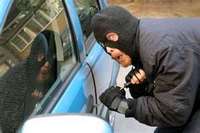LoJack Corporation Issues Vehicle Theft Trendwatch Based On FBI's Uniform Crime Report
 |
In-Depth Look at Numbers Reveals Plummeting National Recovery Rate of Stolen Vehicles; Dramatic Increase in States & MSAs with Rising Vehicle Theft Rates
CANTON, MA--Nov. 20, 2012: While the FBI's newly released 2011 Uniform Crime Report* indicated that vehicle theft in the U.S. decreased again for the year, a close look at the numbers reveals several troubling trends including the lowest national recovery rate of stolen vehicles since 1981 and significant vehicle theft increases in several states and MSAs (Metropolitan Statistical Areas).
According to vehicle theft protection experts at LoJack Corporation , one of the biggest continuing trends is that the percentage of vehicles stolen and recovered has dropped to a 30-year low -- this time by a full four percentage points -- to only 52 percent. With this drop, nearly half of the vehicles stolen in 2011 were never returned to their owners -- amounting to 371,800 vehicles. The four percentage point drop represents the largest year-over-year decline since 2000.
Other noteworthy vehicle theft facts revealed in the report include:
- A full 22 states had year-over-year increases in vehicle theft in 2011 vs. only 12 states in 2010; that's an 83% increase in the total number of states which experienced an increase in vehicle theft
- Nearly 40% of MSAs had year-over-year increases in vehicle theft in 2011 vs. 23% in 2010; that's a 74% increase in the number of MSAs with rising vehicle theft rates
- Many MSAs with rising vehicle theft rates are home to international shipping ports (e.g. San Francisco, CA; Savannah, GA and Bridgeport, CT), where stolen cars can be hidden in steel containers and shipped overseas
- Among the MSAs with rising vehicle theft rates, many are within 250 miles of San Francisco's international port, including Chico, Merced, Napa, Redding, Salinas, San Luis Obispo, Santa Cruz and Yuba City.
- One-third of all vehicle thefts in the U.S. occurred in the four states bordering Mexico (California, Arizona, New Mexico and Texas)
Patrick Clancy, Vice President of Law Enforcement at LoJack Corporation, explained that one key story behind these numbers is the increasingly sophisticated tactics of organized international crime rings, who know just how to "steal and conceal" vehicles.
"These professional thieves -- many of whom are part of highly sophisticated global theft rings -- know just what vehicles they want to steal and just how to outsmart newer vehicle technologies like Smart Keys to get them," said Clancy. "These professional thieves are also adept at concealing stolen vehicles, putting them in shipping containers for exportation overseas or simply disengaging overt location-based technology by removing antennas. These are among the factors driving the recovery rate down each and every year and why we caution consumers to be more vigilant than ever about protecting their vehicles from theft. It also makes a strong case for using a Stolen Vehicle Recovery System, like the LoJackŪ System, which is highly effective at tracking stolen vehicles as more than 90 percent of cars, light trucks and SUVs equipped with the LoJack System that were reported stolen in 2011 in the U.S. were recovered. This is due in large part to our direct integration with law enforcement and proven Radio Frequency technology, which works even if stolen vehicles are hidden in steel containers, concrete garages or dense foliage."
Theft Protection Tips
LoJack Corporation recommends that vehicle owners follow the theft
protection tips outlined below to help keep their vehicles safe from
today's criminals:
Use Common Sense:
- Be careful where you park your car and to whom you entrust your vehicle
- Never leave a key or key fob in the vehicle
- Close all windows; lock all doors
- Park in a well-lit area to deter thieves from doing their dirty work
- When at home, park in the garage
- When you use valet services, make sure they are reputable (many thieves pose as valets and simply drive off with your car)
- Hide all valuables, as they entice thieves to take your car -- and what's inside
- Never program your home address as "home" in your GPS navigation system -- it's an easy way for a thief to find your house, gain access to it and burglarize it
Use Theft Prevention Products:
- While thieves can get around most of these, they may be less inclined to steal your vehicle if it has visible or audible warning devices like a wheel lock or alarm system. Immobilizers (kill switches and fuel cut-off devices) offer another means of protection, even though thieves often disable them.
Use a Tracking and Recovery System:
- Since thieves can disarm theft prevention devices, recovery systems can
provide the peace of mind that you'll get your car back in the event it is
stolen. Effective systems like the LoJack System are directly integrated
with and used by police, use Radio Frequency technology €“
which has proven to be optimal for stolen vehicle recovery as it can track
vehicles hidden in steal shipping containers, concrete garages or dense
foliage -- and are covert because it is nearly impossible to
find and disengage the system.
How the LoJack System Works
The LoJack Stolen Vehicle Recovery System offers the technology and
recovery process that make it an effective system for recovering stolen
vehicles. Based on Radio Frequency technology, the system delivers strong
signals that do not require line of sight with satellites or cell towers
and can therefore track vehicles where other devices can't, such as in a
steel container on a ship, in a parking garage or in dense foliage. The
LoJack System is also directly integrated with law enforcement agencies
around the country, which use LoJack Police Tracking Computers to find and
recover stolen vehicles. Lastly, the system utilizes a small wireless Radio
Frequency transceiver--now self-powered--that is
highly covert, making it very difficult for thieves to find and disengage
the system.


